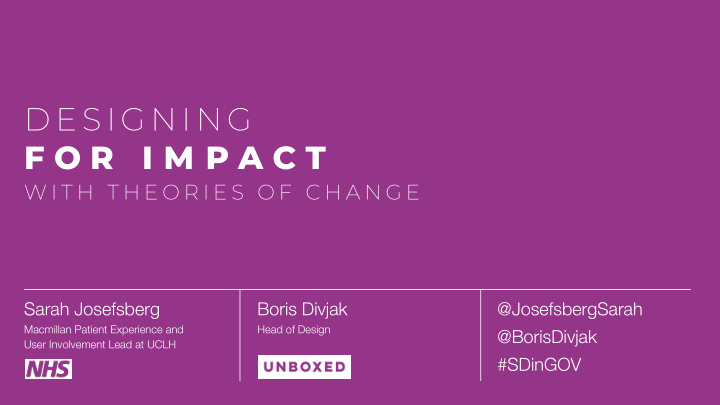



D E S I G N I N G F O R I M P A C T W I T H T H E O R I E S O F C H A N G E Sarah Josefsberg Boris Divjak @JosefsbergSarah Macmillan Patient Experience and Head of Design @BorisDivjak User Involvement Lead at UCLH #SDinGOV
SESSION STRUCTURE @JosefsbergSarah @BorisDivjak 1 2 3 Understanding Linking desired Prototyping and long-term outcomes Theories of Change validating potential to new service impact concepts (your own Theory of Change)
U N D E R S T A N D I N G T H E O R I E S O F C H A N G E
THEORIES OF CHANGE @JosefsbergSarah @BorisDivjak Visual tool (logic model) that makes explicit the steps needed to bring about change.
THEORIES OF CHANGE @JosefsbergSarah @BorisDivjak But a Theory of Change is more than a static logic model: Participatory and iterative process (evolutionary) ● Starts with the desired long-term outcome and work backwards towards needed ● interventions Makes explicit the underlying assupmtions ● Explores complex processes that underlie social and societal change ● (social, economic, political and institutional)
THEORIES OF CHANGE @JosefsbergSarah @BorisDivjak ‘Theory of change is an on-going process of reflection to explore change and how it happens and what that means for the part we play in a particular context.’ ––– James, C. (2011) “Theory of Change Review. A report commissioned by Comic Relief”
THEORIES OF CHANGE AND SERVICE DESIGN @JosefsbergSarah @BorisDivjak Service designers can use Theory of Change for: Ideation – use intermediate outcomes as triggers for creative thinking ● Prototyping and validation – design tests to provide evidence for impact of ● proposed service conepts Collaboration – identify others that are working towards similar long-term outcomes ●
THEORIES OF CHANGE AND SERVICE DESIGN @JosefsbergSarah @BorisDivjak Example service concept to prototype and the outcome to validate
THEORIES OF CHANGE AND SERVICE DESIGN @JosefsbergSarah @BorisDivjak Example service concept to prototype and the outcome to validate
STANDARDS OF EVIDENCE @JosefsbergSarah @BorisDivjak Plan your approach to validation according to the stage of your project and resources at your disposal. Nesta (2013) Standards of Evidence
A C T I V I T Y 1: L I N K I N G D E S I R E D L O N G - T E R M O U T C O M E S T O N E W S E R V I C E C O N C E P T S
EXAMPLE OUTCOME PACKS @JosefsbergSarah @BorisDivjak Form groups with 3–5 people ● Each group to choose one case study and matching ● ‘ example outcomes’ pack to work with for the next exercise Prepare the ‘Theory of Change’ template ●
EXAMPLE OUTCOME PACKS – 3 CARD TYPES @JosefsbergSarah @BorisDivjak SERVICE INTERMEDIATE LONG-TERM CONCEPT OUTCOME OUTCOME
BUILDING THE THEORY OF CHANGE (15 min) @JosefsbergSarah @BorisDivjak Chose one of the long-term outcomes cards (your intended impact) 1. and place it on the template. 2. Now work backwards from the long-term outcome. Identify a number of intermediate outcomes that might lead to the long-term outcome and arrange them in a logical sequence. (take time to discuss and feel free to deviate from the template if needed)
BUILDING THE THEORY OF CHANGE (15 min) @JosefsbergSarah @BorisDivjak See if any of the ‘new service concept ’ cards fits your intermediate 3. outcomes and place them on the template (or propose your own!). 4. Discuss and refine . Look at the outcomes chain you’ve created: Does it make sense to everyone in the group? ● Are there any gaps or missing links? ● Would this be achievable within the culture of the organisationand the given ● context? Are there any negative outcomes we forgot about? ●
A C T I V I T Y 2: P R O T O T Y P I N G A N D V A L I D A T I N G P O T E N T I A L I M P A C T
PROTOTYPING AND VALIDATION CARDS / TEMPLATE Prepare the ‘Prototyping and validation’ template and cards ●
PLANNING PROTOTYPING AND VALIDATION (15 min) Formulate the assumption you aim to validate (or disprove): 1. take the service concept and one of its intermediate outcomes , and place them on the template, forming an ‘if … then’ statement 2. Discuss and define a way to measure the outcome What is the best measurable indicator for the chosen outcome (e.g. number ● of calls, self-reported user experience, ...)? Is this measure really indicative of this outcome or could it be indicating ● something else (e.g. counting homeless example)?
PLANNING PROTOTYPING AND VALIDATION (15 min) Use the ‘prototyping’ and ‘validation’ cards to refine your approach. 3. Consider different options and their pros/cons. 4. Discuss conditions for your test; what will you need to prepare for everything to run smoothly and to get good results? 5. What would be a successful result? What kind of result would validate (or disprove) your initial assumption?
Q U E S T I O N S / F E E D B A C K? W W W . P R O T O T Y P I N G F O R I M P A C T . C O M Sarah Josefsberg Boris Divjak @JosefsbergSarah Macmillan Patient Experience and Head of Design @BorisDivjak User Involvement Lead at UCLH #SDinGOV
Recommend
More recommend